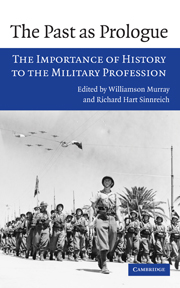Book contents
- Frontmatter
- Contents
- Contributors
- 1 Introduction
- 2 Military history and the history of war
- Part I The influence of history on the military profession
- Part II The past as illuminator of the future
- 7 Thucydides as educator
- 8 Clausewitz, history, and the future strategic world
- 9 History and the nature of strategy
- 10 Military transformation in long periods of peace: the Victorian Royal Navy
- 11 Military history and the pathology of lessons learned: the Russo-Japanese War, a case study
- 12 Obstacles to innovation and readiness: the British Army's experience, 1918–1939
- 13 What history suggests about terrorism and its future
- 14 History and future of civil–military relations: bridging the gaps
- Index
12 - Obstacles to innovation and readiness: the British Army's experience, 1918–1939
Published online by Cambridge University Press: 05 June 2012
- Frontmatter
- Contents
- Contributors
- 1 Introduction
- 2 Military history and the history of war
- Part I The influence of history on the military profession
- Part II The past as illuminator of the future
- 7 Thucydides as educator
- 8 Clausewitz, history, and the future strategic world
- 9 History and the nature of strategy
- 10 Military transformation in long periods of peace: the Victorian Royal Navy
- 11 Military history and the pathology of lessons learned: the Russo-Japanese War, a case study
- 12 Obstacles to innovation and readiness: the British Army's experience, 1918–1939
- 13 What history suggests about terrorism and its future
- 14 History and future of civil–military relations: bridging the gaps
- Index
Summary
Less than twenty-one years separated the Armistice of November 1918 from the British Army's renewed commitment to a continental war in September 1939. Until 1931, the British Army could reasonably claim leadership in crucial areas of military theory and practice – most notably, in mechanization and in the development, organization, and employment of armored forces. After 1933, however, the British General Staff looked with an increasing fascination at the burgeoning power and skill of the German Army. For reasons to a certain extent beyond its control, it was unable to make an adequate response. By 1935, Britain's lead in the development of armored forces had clearly been lost. Desperately weak and unready in 1939, the British Army's performance for much of the Second World War was distinctly poor.
For much of the First World War, too, the British Army had struggled to bring itself up to the standards of competence of the French, much less the Germans. (The latter were undoubtedly the most efficient in the world until near the end of that conflict.) But British difficulties in achieving such standards are hardly surprising. The little army fielded in August 1914 was by no means a “contemptible force.” It was at least the qualitative equal of its vastly larger continental contemporaries. By year's end, however, the intense fighting had destroyed much of it.
- Type
- Chapter
- Information
- The Past as PrologueThe Importance of History to the Military Profession, pp. 195 - 216Publisher: Cambridge University PressPrint publication year: 2006



